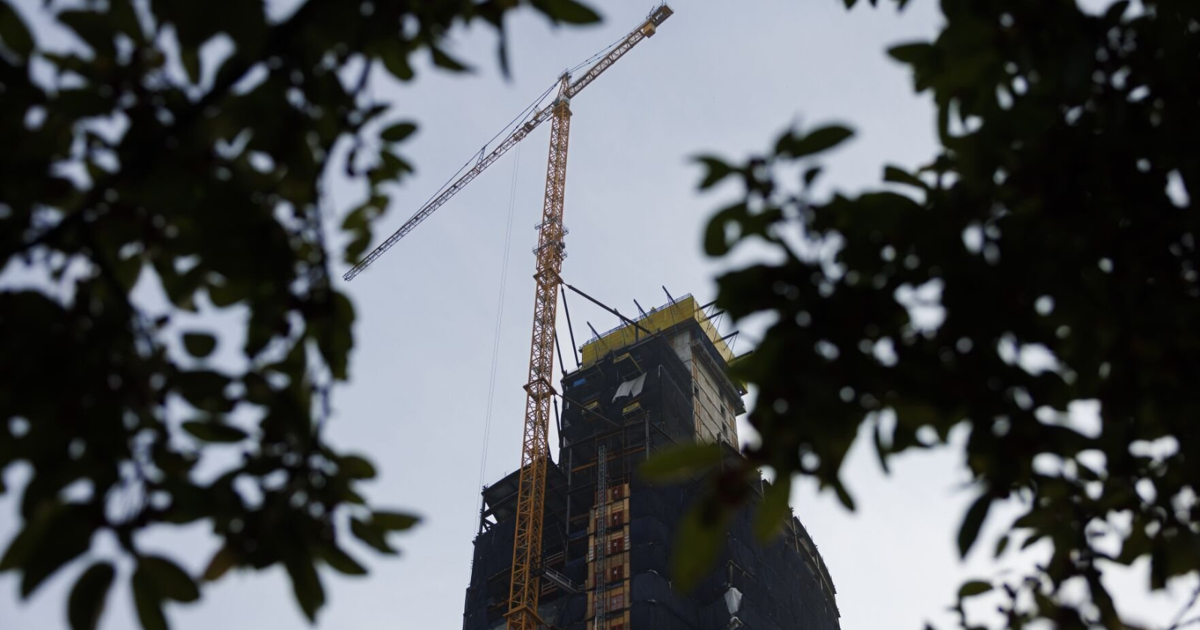By Henry J. Cordes,Henry J. Cordes World-Herald Staff Writer
Copyright omaha

Look around Omaha, and you can see many signs of seeming prosperity.
People are flocking by the millions to the city’s signature riverfront parks.
Mutual of Omaha’s new headquarters tower alters the city’s skyline as it steadily rises over downtown.
Earlier this year, the population of the eight-county metro area eclipsed the 1 million mark.
But those appearances may be masking what some Omaha business leaders see as a quietly building economic crisis: Employment in the Omaha metro has been growing at a sluggish pace, badly trailing its regional peers.
In the past five years, Omaha’s annual average job growth rate has been a fraction of 1%. Metro Des Moines is booming in comparison, with a growth rate more than three times Omaha’s, according to a World-Herald analysis of federal employment data.
What’s more, Kansas City is growing jobs more than twice as fast; Denver almost four times faster; Oklahoma City more than four times faster; and Sioux Falls, South Dakota, more than five times faster.
In that same time, Lincoln’s employment growth is only a tick higher than Omaha’s.
A recent consultant report commissioned by Omaha’s Aksarben Foundation spotlighted the non-competitive job growth in Nebraska’s two largest metro areas. It also found that lagging growth is costing the state thousands of potential jobs, billions of dollars in wages and hundreds of millions in state taxes.
“The state is caught in a concerning cycle: underperforming metros generate less wages and tax revenue, which limits the state’s ability to invest in infrastructure, education or economic development initiatives, which potentially perpetuates the economic underperformance,” said the report from Development Counsellors International, a global research and marketing firm based in New York that specializes in economic development and talent attraction and works with government bodies around the world.
Lack of progress on workers
While the numbers are stark, the reasons for Omaha’s lagging job growth figures are less clear.
But business leaders associated with the Aksarben Foundation say they reveal a clear lack of progress in addressing the state’s chronic shortage of workers.
The region for years has failed to attract enough workers to meet demand, often leaving jobs going wanting. The state also continues to be plagued by a significant “brain drain” — a net exodus of college-educated people from the state.
“Absent a willingness for change, the loss of people and jobs will continue,” said Dana Bradford, a past chairman of both the Greater Omaha Chamber and Aksarben. “The facts are the facts, and it is time we face them and begin to do something about what they are telling us.”
Business leaders offer other anecdotal evidence of how the state is failing to attract, compete for and retain talent.
Omaha’s Signature Performance, a fast-growing, homegrown medical technology and claims processing firm, was founded in 2004 with eight workers. Today, it employs some 1,500.
But now only about half of those workers are based in Nebraska, down from almost three-quarters five years ago. While five years ago 25% of its applicants were Nebraskans, today it’s just 6%.
“It’s related to the talent availability and the size of the labor force in Nebraska simply not being sufficient enough to accommodate our growth needs, and we’re not alone,” said company CEO and founder Allen Fredrickson. “Our preference is to grow in Nebraska.”
Fredrickson said Signature Performance is expected to add another 1,000 jobs in coming years. The number that will ultimately be located in Nebraska will depend directly on the number of workers the firm can hire here.
Mike Cassling, an Omaha business executive who chairs Aksarben’s board of governors, said he has heard many similar stories. “Slowly, quietly, companies are just putting people in other states,” he said.
Bradford, Cassling and others say the lack of growth shows it’s time for state policymakers to get serious about making Nebraska a more attractive place to live and work.
Business leaders interviewed said those efforts should include updating business incentives to target the creation of high-wage jobs, overhauling the state’s tax system, and doing more to promote the opportunities and high quality of life available in the state.
Governor Jim Pillen, who was briefed on the Aksarben study’s findings in advance of its release Tuesday, said he agrees addressing the state’s workforce challenge is one of the state’s top strategic priorities.
“I’m grateful to anyone, including the backers of this initiative, who are committed to doing thoughtful work to understand this challenge and develop solutions to meet it,” he said. “My administration will remain laser-focused on making sure our state does everything possible to attract great people to ‘The Good Life.’ ”
Omaha Mayor John Ewing had also been briefed on the numbers. In the recently passed city budget, Ewing increased city funding from $175,000 to $350,000 for the Omaha chamber’s economic development arm, hoping to boost recruitment efforts.
“I want to be much more aggressive in trying to retain businesses in Omaha and be aggressive in recruiting businesses to Omaha,” Ewing said.
Mike Yanney, a longtime Omaha business leader, likens the current moment to the wake-up call Nebraska received four decades ago. That’s when Northern Natural Gas left Omaha and ConAgra threatened to move out, actions that spurred Nebraska to create its first major tax incentives program.
Yanney said the challenge this time is to do whatever it takes to make the state more attractive to potential workers, particularly young people.
“We have to make changes, and those changes have to be made boldly and with the fact it’s also going to cost money,” he said. “You don’t move cultures overnight, and this is a cultural move.”
Alarm sounded on workers
Six years ago, the Omaha, Lincoln and state chambers began to sound the alarm over the state’s workforce shortage.
Whether from entrepreneurial new startups or the state’s legacy corporate stalwarts, business leaders said their firms were struggling to find the workers they needed. And they warned the state would lose out on thousands of jobs if things did not get turned around.
The Aksarben Foundation, a century-old civic organization whose board has historically been populated by some of Omaha’s most prominent business leaders, has made Nebraska’s workforce challenges one of its primary policy thrusts.
To get a pulse on how competitive Omaha has recently been in the nationwide fight for jobs and workers, Aksarben commissioned DCI to study it.
DCI found that in the five-year period covering 2020 to 2024, Omaha and Lincoln both posted annual job growth of roughly one half of 1 percent.
It found the two metros’ growth rate was one-fifth that of a comparison group of seven metros, including Des Moines, Sioux Falls, Colorado Springs, Boise, Idaho, Huntsville, Alabama, Fayetteville, Arkansas and Raleigh, North Carolina.
“Both areas are really sort of struggling,” said Robyn Domber, senior vice president for research with DCI.
Domber said the comparison cities chosen all have economies similar to those of Omaha and Lincoln. They include true regional peers as well as other fast-growing mid-sized metros around the country that are more “aspirational” in nature.
The report concluded if Omaha and Lincoln had grown employment and wages at the collective rate of the comparison cities, it would have added 68,000 more jobs, $11 billion in wages and collected between $600 million and $800 million in additional state taxes.
Currently, the state is facing an annual budget deficit of nearly $100 million that is expected to worsen.
To see how Omaha and Lincoln stacked up against a more regional comparison group, the World-Herald used federal nonfarm jobs data for a similar analysis — and found equally lackluster results.
The World-Herald’s analysis, using a somewhat different timeframe and data set and a different averaging method, found Omaha added only 8,000 nonfarm jobs over those five years, less than the 12,000 in the DCI study. The Omaha metro had just over 500,000 nonfarm jobs at the start of the period, so either figure represents minimal growth over five years.
The average annual job growth was only 3 tenths of 1 percent for Omaha and 4 tenths for Lincoln. Both figures badly lagged Kansas City, Oklahoma City, Denver and Tulsa in addition to Des Moines, Sioux Falls and Colorado Springs.
The two Nebraska metros weren’t alone in their struggles, as Minneapolis, St. Louis and Chicago also posted poor results.
Looking so far this year, the numbers are more mixed.
Seasonally adjusted data suggests Omaha has actually lost almost 1,000 jobs since December, while its year-over-year figure is up about .5%. Lincoln’s 2025 numbers are better, up .7% since December and 1.7% year-over-year.
In an apparent oddity in the federal jobs data, the state as a whole added nonfarm jobs between 2020 and 2024 at about double the annual rate of Omaha and Lincoln, at .6%. The metro areas tend to lead state growth.
The data suggests the metros’ lack of growth in recent years has exacted a heavy economic toll. According to the World-Herald’s figures, if Omaha had grown at the same rate as Des Moines between 2020 and 2024, it would have added 21,000 more jobs than it did.
Omaha, Lincoln economic engines
The DCI report noted that Omaha and Lincoln account for roughly 60% of Nebraska’s jobs and wages, making them important economic engines for the state.
“There is no opportunity for Nebraska’s economy to prosper if the two largest cities are unable to compete and grow employment and wages,” the report said.
The Greater Omaha Chamber recognizes the same “headwinds” spotlighted in the DCI report, said chamber president and CEO Heath Mello. His organization saw similar numbers in its own strategic assessment last year, finding Omaha was lagging amid an “extremely competitive” jobs market.
“The stark reality is the Greater Omaha region must improve in key areas such as population growth, employment growth, wage growth and overall competitiveness,” Mello said.
While the DCI report laid out the slow metro growth, it did not delve deeply into the reasons why. That is the subject of an ongoing DCI study.
But Domber said in her firm’s experience working with business site selectors, many firms are reluctant to locate new jobs in areas that are experiencing brain drain. They want to make sure a city can meet not only current worker needs, but future ones, too.
“If they don’t see that talent pipeline growing, that’s going to be a red flag,” she said.
The DCI report noted regions that tend to grow the fastest typically have lower tax rates, competitive incentive packages and work hard to promote and sell themselves.
Nebraska has above-average income taxes and among the nation’s highest property taxes, the report said. And its business tax incentives in dollar terms appear to rank on the low side, according to a study cited in the DCI report.
The DCI report noted Iowa and Kansas are both scoring more business site-selection victories than Nebraska. If a state is not attracting corporate investment, Domber said, it can be hard to build the momentum needed to attract workers.
Domber said her firm is also a big believer in economic marketing.
“I think it’s a combination of things, certainly policy, but also just marketing the state to the right decision-makers as well,” she said.
Curious case of Omaha, Des Moines
In determining why Nebraska’s metros are lagging, getting to the root of why Des Moines is so badly outstripping Omaha might be a good starting point.
Both Omaha and Des Moines are the most populous cities in their largely agricultural states, and both feature diverse economies. While some might suggest the growth disparity relates to tax differences, Des Moines and Omaha actually have very similar tax structures.
In fact, an annual study produced by Washington, D.C. that compares state and local tax burdens on typical families in the largest city of each state rates Des Moines’ taxes slightly higher than Omaha’s at most income levels. That includes higher property taxes.
Creighton University economist Ernie Goss found the cities’ growth differences curious, but said something appears to be at work.
He was recently looking at data on insurance jobs that showed Des Moines since 2019 has added 2,000 jobs in the industry, while Omaha has lost 3,000 such jobs.
“Man, that’s a lot of jobs just in that one industry,” he said.
Nebraska’s shortage of affordable housing also could be playing into it. Des Moines, while smaller, in recent years has been building more new single-family homes than Omaha.
Brain drain could also help tell the story, said Josie Schafer, a University of Nebraska at Omaha demographer who has tracked the trend in Nebraska.
While Omaha in 2023 posted a net loss of 1,228 college graduates — with that many more moving in than out — Des Moines posted a gain of 463. Both Omaha and Lincoln also posted higher brain drain rates than Kansas City, Oklahoma City, Sioux Falls, Denver and Colorado Springs.
Since 2010, according to Schafer’s data, Nebraska has seen a net loss of more than 34,000 college graduates.
“We’re all telling the same story,” Schafer said.
Fredrickson, the Signature Performance CEO, said when he looks at the other cities in the Aksarben study, he sees no reason why a vibrant and livable city like Omaha shouldn’t be doing as well, if not better.
He said Nebraska needs to do a better job of telling its story and marketing itself to others, both here and elsewhere. He said the state also should do more to improve its tax climate and education system and become “a more welcoming state.”
“We shouldn’t settle for where we are,” he said. “I think it’s solvable, but it’s going to take a great deal more intentionality than we have to this point. We know that this is a great place.”



